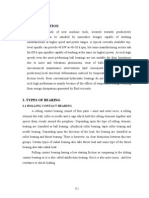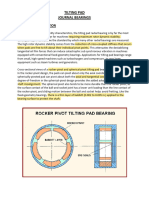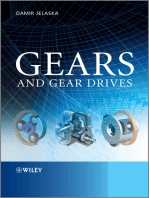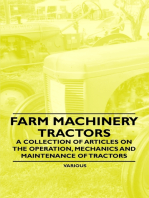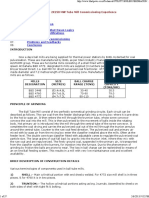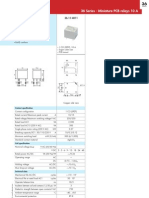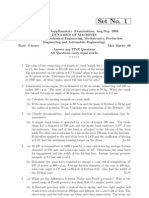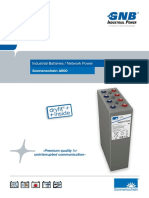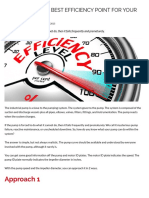Professional Documents
Culture Documents
Study of Shaft Position in Gas Turbine Journal Bearing
Study of Shaft Position in Gas Turbine Journal Bearing
Uploaded by
arindam misraOriginal Title
Copyright
Available Formats
Share this document
Did you find this document useful?
Is this content inappropriate?
Report this DocumentCopyright:
Available Formats
Study of Shaft Position in Gas Turbine Journal Bearing
Study of Shaft Position in Gas Turbine Journal Bearing
Uploaded by
arindam misraCopyright:
Available Formats
th
Proceeding of 9 International Seminar on Industrial Engineering and Management
ISSN : 1978-774X
STUDY OF SHAFT POSITION IN GAS TURBINE JOURNAL BEARING
Rizky Arman, Iman Satria
Mechanical engineering Dept. Faculty of Industrial Technolgy,
Bung Hatta University, Padang 25143, Indonesia
rizky.arm@gmail.com
ABSTRACT
Bearings provide the primary interface between the moving and the stationary parts of a
machine. Although the seal and the process fluids (or magnetic fields) coexist, the bearings
provide the majority of the stiffness and damping for the moving assembly. It is
understandable that dynamic forces developed on the moving part are transmitted to the
stationary part across these main support bearings. The forces may be the static radial loads
due to the rotor weight, or they may be dynamic forces due to mechanisms such as mass
unbalance. In either case, the radial bearings must carry the applied loads, or the machine will
fail. In most cases, it is technically difficult (if not impossible) to directly check the validity or
accuracy of the computed bearing coefficients. However, each calculation must conclude with
a force balance, plus a position balance of the journal within the bearing clearance. It is
reasonable to believe that if the calculated eccentricity position is correct, than the other
computed parameters are also representative of the bearing characteristics [a]. Since journal
within an oil film bearing can be measured directly with proximity probes, it is logical perform a
check of the analytical prediction versus actual machine data. For this case history, consider a
group of four single shaft gas turbines that operate between 5,000 and 5,350 RPM. These
units are rated at 40,000 HP, and they are used to drive high pressure centrifugal
compressors through a single helical gear box. The shaft sensing proximity probes are
mounted at ±450 from the true vertical centerline. At turbine inlet end#1 bearing, the probes
are mounted above the shaft. Conversely, at the exhaust end #2 bearing, the probes are
located below the shaft.
Key words: journal bearing, gas turbine, proximity probes.
1. INTRODUCTION bearing allowing high shaft speeds and
heavy loads. Industrial machinery with high
Bearings are used to prevent friction horsepower and high loads, such as steam
between parts during relative movement. In turbines, centrifugal compressors, pumps
machinery they fall into two primary and motors, utilize journal bearings as rotor
categories: anti-friction or rolling element supports. One of the basic purposes of a
bearings and hydrodynamic journal bearing is to provide a frictionless
bearings. The primary function of a bearing environment to support and guide a rotating
is to carry load between a rotor and the case shaft. Properly installed and maintained,
with as little wear as possible. This bearing journal bearings have essentially infinite life.
function exists in almost every occurrence of In most cases, it is technically difficult (if
daily life from the watch on your wrist to the not impossible) to directly check the validity
automobile you drive to the disk drive in your or accuracy of the computed bearing
computer. In industry, the use of journal coefficients. However, each calculation must
bearings is specialized for rotating conclude with a force balance, plus a
machinery both low and high speed [a], [b]. position balance of the journal within the
Fluid film bearings are the most widely bearing clearance. It is reasonable to believe
used plain bearing. They rely on lubricant that if the calculated eccentricity position is
viscosity to separate the bearing surfaces. correct, than the other computed parameters
The rotating shaft drags the lubricant around are also representative of the bearing
forming a supporting wedge. These bearings characteristics. Since journal within an oil
usually need a lubrication system. The film bearing can be measured directly with
continuous lubrication acts to cool the proximity probes, it is logical perform a
Study of Shaft Position
Rizky Arman PS-115
th
Proceeding of 9 International Seminar on Industrial Engineering and Management
ISSN : 1978-774X
check of the analytical prediction versus diameter. A babbit lining provides a surface
actual machine data. which will not mar or gouge the shaft if
contact is made and to allow particles in the
lubricant to be imbedded in the liner without
2. THEORETICAL BACKGROUND damaging the shaft. Journal bearings have
many differing designs to compensate for
A journal bearing, simply stated, is a differing load requirements, machine
cylinder which surrounds the shaft and is speeds, cost, or dynamic properties. One
filled with some form of fluid lubricant. In this unique disadvantage which consumes much
bearing a fluid is the medium that supports research and experimentation is an
the shaft preventing metal to metal contact. instability which manifests itself as oil whirl
The most common fluid used is oil, with and oil whip. Left uncorrected, this
special applications using water or a gas. phenomenon is catastrophic and can
This application note will concentrate on oil destroy the bearing and rotor very quickly.
lubricated journal bearings [b],[c],[d]. Oil whip is so disastrous because the rotor
Hydrodynamic principles, which are active cannot form a stable oil wedge consequently
as the shaft rotates, create an oil wedge that allowing metal to metal contact between the
supports the shaft and relocates it within the rotor and the bearing surface. Once surface
bearing clearances. In a horizontally split contact exists the rotor begins to precess, in
bearing the oil wedge will lift and support the a reverse direction from rotor rotation
shaft, relocating the centerline slightly up direction, using the entire bearing clearance.
and to one side into a normal attitude This condition leads to high friction levels
position in a lower quadrant of the bearing. which will overheat the bearing babbit metal
The normal attitude angle will depend upon that leads to rapid destruction of the bearing,
the shaft rotation direction with a clockwise rotor journal, and the machine seals. Some
rotation having an attitude angle in the lower common designs employed are lemon bore,
left quadrant. External influences, such as pressure dam, and tilt pad bearings. These
hydraulic volute pressures in pumps or designs were developed to interrupt and
generator electrical load can produce redirect the oil flow path within the bearing to
additional relocating forces on the shaft provide higher bearing stabilities. Journal
attitude angle and centerline position. An bearings installed in industrial machinery
additional characteristic of journal bearings today generally fall into two categories: full
is damping. This type of bearing provides bearings and partial arc bearings. Full
much more damping than a rolling element bearings completely surround the shaft
bearing because of the lubricant present. journal with many differing geometries such
More viscous and thicker lubricant films as elliptical, lobed, or pressure dam
provide higher damping properties. As the configurations and usually are two pieces,
available damping increases, the bearing mated at a split line. Partial arc bearings
stability also increases. A stable bearing have several individual load bearing
design holds the rotor at a fixed attitude surfaces or pads and are made up of
angle during transient periods such as numerous adjustable components [e], [f].
machine startups/shutdowns or load Use of journal bearings is also an
changes. The damping property of the advantage in many applications when it
lubricant also provides an excellent medium comes to maintenance. Most fluid film
for limiting vibration transmission. Thus, a bearings are split and rotor removal is not
vibration measurement taken at the bearing required to inspect and replace. While split
outer shell will not represent the actual rolling element bearings are also available
vibration experienced by the rotor within its they are costly and not common. Journal
bearing clearances. bearing fatigue damage is usually visible at
The bearing inner surface is covered an early stage and allows for better
with a softer material, commonly called diagnostics of failure modes so that
babbit. Babbit, which is a tin or lead based corrective action can be taken to prevent
alloy, has a thickness that can vary from 1 to recurrence. The operating range for different
100 mils depending upon the bearing types of bearing is shown in Figure 1.
Study of Shaft Position
PS-116 Rizky Arman
th
Proceeding of 9 International Seminar on Industrial Engineering and Management
ISSN : 1978-774X
Xo = static radial factor
Yo = static axial factor
(The values of Xo & Yo are given in the
Bearing Data). The Basic Static Load Rating
Co can be calculated from:
𝐶𝑜 = 𝑆𝑜𝑃𝑜 (3)
where
Co = basic load rating (N)
So = static safety factor
Po = equivalent static bearing load (N)
Values of So depend on the type of
bearing and the requirements regarding
Figure 1 Operating ranges for different types quiet running. If the bearing is stationary for
of bearing long periods or rotates slowly and is subject
to shock loads then the bearing selection
procedure is based on this basic load rating.
3. RESEARCH METHOD: STATIC AND Values of Co for each bearing are quoted in
DYNAMIC LOAD CARRYING the bearing catalogues. Choose a bearing
CAPACITY whose quoted value for Co is equal to the
required value of Co calculated above, and
In the development of analytical static safety factor is shown at Table 1.
machinery models, there is always a
temptation to begin the project with a Table 1. Guidelines for static safety factor
detailed rotor analysis. However, the
machinery diagnostician soon discovers that
bearing characteristics must be defined and
included within the rotor model. In some
cases, such as the optimization of a
mechanical system, many different bearing
types may be considered with different rotor
models. Hence, it is often an iterative The dynamic load carrying capacity of a
procedure to determine the proper bearing is dependent on the dynamic forces
combination of bearings and rotor acting on the bearing as well as the basic
configuration. One of the easiest and static forces. The first step is therefore to
informative starting points is the calculate the Static Load Rating before
determination of the static shaft loading continuing with the following procedure. If
upon the planar area of the bearing [g], [h]. the bearing is subject to radial and axial
The Basic Static Load Rating given for forces then an equivalent dynamic bearing
each bearing in bearing catalogues is based load must be calculated:
on the stationary axial and radial forces 𝑃 = 𝑋𝐹𝑟 + 𝑌𝐹𝑎 (4)
acting on the bearing. When bearings are
subject to both radial and axial loadings the P = The equivalent dynamic bearing load
equivalent static load must be found thus: (N)
𝑃𝑜 = 𝑋𝑜𝐹𝑟 + 𝑌𝑜𝐹𝑎 (1) Fr = static radial load on the bearing (N)
Fa= static axial load on the bearing (N)
If only radial forces act then; X = radial factor
𝑃𝑜 = 𝐹𝑟 (2) Y = axial factor
Where When Fa = 0 or Fa is relatively small up
Po = The equivalent static bearing load (N) to a limiting case of Fa/Fr = e (where e is a
Fr = static radial load on the bearing (N) certain limiting value) then:
Fa = static axial load on the bearing (N) 𝑃 = 𝐹𝑟 (5)
Study of Shaft Position
Rizky Arman PS-117
th
Proceeding of 9 International Seminar on Industrial Engineering and Management
ISSN : 1978-774X
(The values of X, Y & e are given in the coefficients. However, each calculation must
Bearing Data) conclude with a force balance, plus a
position balance of the journal within the
Once a value for the equivalent dynamic bearing clearance. It is reasonable to believe
bearing load is obtained it can be used to that if the calculated eccentricity position is
calculate the dynamic load rating of the correct, than the other computed parameters
bearing. This value is used to select the are also representative of the bearing
bearing. Each bearing in the bearing characteristics. Since journal within an oil
catalogue has a quoted value for dynamic film bearing can be measured directly with
load rating and so a bearing should be proximity probes, it is logical perform a
chosen that has a higher rating than the one check of the analytical prediction versus
calculated. The dynamic load rating that is actual machine data [a] [i],[j],[k].
quoted in the catalogues for each bearing is For this case history, consider a group of
dependent on the required life of the bearing four single shaft gas turbines that operate
and the equivalent dynamic bearing load (P). between 5,000 and 5,350 RPM. These units
The ISO equation for basic rating life is: are rated at 40,000 HP, and they are used to
drive high pressure centrifugal compressors
𝐶 𝑝 through a single helical gear box. The shaft
𝐿10 = (𝑃) 𝑜𝑟 𝐶 = 𝑃𝐿101/𝑝 (6)
sensing proximity probes are mounted at
±450 from the true vertical centerline as
Where shown in Figure 2. At turbine inlet end#1
L = basic rated life, Millions of revolutions bearing, the probes are mounted above the
C = basic dynamic load rating shaft. Conversely, at the exhaust end #2
P = equivalent dynamic bearing load bearing, the probes are located below the
p = exponent in the life equation (3 for all shaft [a].
ball bearings and 10/3 for all other
roller bearings)
The basic rated life (defined as the
number of revolutions that 90% of a group of
identical bearings would be expected to
achieve) is determined from the length of life
that is required of the bearing. Typical life
expectancies of required of various
machines are given below.
Table 2. Life expectancies of required of
various machines
4. RESULT AND DISCUSSION: CASE Figure 2 Measurement with proximity probes
HISTORY OF SHAFT POSITION IN on shaft
GAS TURBINE JOURNAL BEARING
The eight inch diameter journals are
In most cases, it is technically difficult (if supported in elliptical bearings. These
not impossible) to directly check the validity bearings have an average vertical
or accuracy of the computed bearing diametrical clearance of 16 Mils (0.016
Study of Shaft Position
PS-118 Rizky Arman
th
Proceeding of 9 International Seminar on Industrial Engineering and Management
ISSN : 1978-774X
inches), and a normal horizontal diameter explanation for these aberrations resides
clearance of 32 Mils. These physical within the characteristics of the proximity
dimensions are consistent with 2:1 probes, and the companion drivers are
clearance. sensitive to operating temperature. The
The shaft centerline position for these temperature limit specification for this
machine journals was determined by specific probe and cable was 3500F; and the
measuring the proximity probe DC gap oscillator-demodulator operating limit was
voltages at a stop condition, and at full specified as 1500F for a standard unit, or
speed. The difference between these DC 2120F for extended temperature range
voltages is divided by the transducer scale version.
factor to determine the position change in
the direction of each transducer. This X-Y
change in radial position may be plotted on a
graph that display the bearing clearance,
plus the calculated journal position in the X
and Y direction [l].
Fig.3 depicts the radial journal positions
for the turbine inlet bearings. Shaft
centerline location for the A unit were Figure 4 Shaft centerline position on journal
obtained on different dates, and at slightly bearings at exhaust end #2
different speeds varying between 5,100 and
5,340 RPM. Three additional machines As shown in Figure 2, the exhaust end
identified as the B, C, and D units are also probes are mounted outboard of the #2
included in these survey. Speeds for these bearing, and below the horizontal centerline.
last three units varied between 5,010 and These probes are subjected to a high
5,350 RPM. It is noted that excellent temperature environment that can easily
agreement has been achieved between the heat the transducer to temperatures in
calculated position at 5,340 RPM, and the excess of 2000F. the oscillator-
six sets of field data. demodulators are mounted in an explosion
proof housing. Although a heat shield is
installed between the turbine exhaust and
this box, the electrical components often
operate at temperatures above 1300F. Thus,
the exhaust end probes, cables, and drivers
are all exposed to elevated temperatures
that affect the calibration curve slope.
For many years, the instrumentation
vendors have recognized that operating
temperature will influence probe calibration.
For instance, Fig.5 depicts the variation in
calibration curves at temperatures of 75,
200, and 3500F. This data was published by
the manufacturer of the proximity probes
Figure 3 Shaft centerline position on journal installed on these particular gas turbines.
bearings at inlet end #1 The plotted data is for a 0.300 inch diameter
probe. Larger excursions are normally
The same position information for the exhibited by smaller diameter probe tips.
exhaust end #2 bearing as contained in From this family of curves, it is clear that the
Figure 4. Notice that the scatter of data is calibration curve will bend downward as the
much greater at this bearing, and the temperature increase. At 2000F, the
deviations from the calculated position are calibration curve is nominally 0.5 volts below
substantial. Initially, it might be concluded the normal curve for gaps in the vicinity of -
that the theory does not support the actual 9.0 to -10.0 volts DC. Hence, for a given
machinery behaviour. However, a partial distance between the probe and shaft, the
Study of Shaft Position
Rizky Arman PS-119
th
Proceeding of 9 International Seminar on Industrial Engineering and Management
ISSN : 1978-774X
output DC voltage from the Proximitor® is compensate for the transducer temperature
reduce by about 0.5 volts. Since the sensitivity, the result are shown in Table 4.
measurement system operates with negative The initial cold gap voltages (zero speed)
bias, the gap voltages are likewise negative. remain the same as before.
The displacement shift is again
determined by dividing the differential gap
voltages by 0.2 Volts/Mil to determine the
distance shift. For the Y-axis probe, this
yields a displacement change of 0.35 Mils
away from the probe. The X-axis transducer
now displays a -1.74 volt change, which is
equal to an 8.70 Mil position shift away from
the transducer. The total shift of the journal
centerline position is therefore equivalent to
a vector shift of 8.71 Mil at 470 (cold to hot
position). Thus, the temperature correction
reveals that the shaft is really riding higher in
the bearing than the uncorrected data
revealed.
Figure 5 Variation in calibration curves at
temperatures of 75, 200, and 3500F Table 4. Corrected Proximity Probe Gap
Voltages At Turbine Exhaust End #2 Bearing
The correction for this temperature
behaviour requires adding the incremental
voltage to the Proximitor® output voltage.
Thus, the measured output DC voltage
should be corrected by -0.5 volts DC to yield
a temperature compensated value. Correcting each of the hot gap voltages
Specifically, Table 3 summarizes the cold (at from the initial shaft centerline diagram
stop) gap voltages, plus the hot (running) produces the journal positions presented in
gap voltage or the B machine. Fig.6. Again, the exhaust end probes are
mounted on the bottom of the shaft, and the
Table 3. Direct Proximity Probe Gap corrected DC voltages reveal a shaft rise.
Voltages At Turbine Exhaust End #2 Bearing
The differential gap voltages are merely
the cold minus the hot gap voltages at the
Figure 6 Corrected Proximity Probe Gap
turbine exhaust bearing. Dividing the Y-axis
Voltages At Turbine Exhaust End #2 Bearing
(vertical) probe differential gap voltage by
the normal transducer sensitivity of 0.2
It is evident that agreement between the
Volts/Mil) yields a displacement change of
calculated and measured journal position
2.15 Mils towards the probe. Similarly, the X-
has been significantly improved by this
axis (horizontal) transducer exhibits a -1.24
simple probe gap temperature correction.
volt change, which is equivalent to a 6.20 Mil
The remaining deviations in measured radial
position shift away from the probe. This is
position between both ends of the turbine
equivalent to an overall shaft vector shift of
may now be attributed to the presence of
6.56 Mils at 260 from the cold to the hot
external loads, moments, or other influences
position.
acting upon the shaft.
However, if the measured hot probe gap
voltages are corrected by -0.5 volts DC to
Study of Shaft Position
PS-120 Rizky Arman
th
Proceeding of 9 International Seminar on Industrial Engineering and Management
ISSN : 1978-774X
Since the inlet end #1 Bearing is 6. REFERENCES
adjacent to the accessory coupling, vary little
torque is transmitted during normal (a) P. Pennacchi and A. Vania, (2011).
operation. Thus, the presence of external “Analysis of the instability phenomena
forces, and misalignment loads are minimal caused by steam in high-pressure
at the front end bearing. As previously turbines,” vol. 18, pp. 593–612.
observed, the measured positions agree (b) M. E. Leader, “Understanding Journal
very well with the theoretical calculations Bearings.”
that consider only the load due to the (c) D. J. Salamone, (1984). “Journal Bearing
applied journal weight. Design Types And Their Applications To
Turbomachinery by,” pp. 179– 190.
(d) “Bearing Supports from Automotion
5. CONCLUSION Components.”
(e) M. He, C. H. Cloud, and J. M. Byrne,
However, at the gas turbine exhaust end (2005). “Fundamentals Of Fluid Film
bearing, the full power output from the Journal Bearing Operation And
turbine is transmitted across the load Modeling.”
coupling. Dependent upon coupling type, (f) W. B. Rowe, K. Cheng, and D. Ives,
alignment position and associated external (1991). “A knowledge-based system for
forces, the actual journal location would the selection of fluid film journal
probably deviated from the predicted bearings,” Tribol. Int., vol. 24, no. 5, pp.
eccentricity that was computed with only the 291–297.
journal weight. In fact, the reverse statement (g) J. D. Irwin, (2001). Mechanical Engineer
might also be appropriate. That is, since the ’ s Handbook Academic Press Series in
exhaust end shaft centerline position agrees Engineering Series Editor.
with the computed location, the influence of (h) J. D. Irwin, (2001). Mechanical Engineer
external forces may be considered to be ’ s Handbook.
minimal (i.e., indicative of a well-aligned (i) C. Jackson, “by,” pp. 73–86, 1960.
Load coupling). (j) G. F. Simmons, (2013). Journal Bearing
Overall, the eccentricity calculations at Design , Lubrication and.
both ends of the turbine appear to be (k) K. R. Guy and D. A. Services, (2007).
realistic and representative of average “11 Problems – 11 Solutions,” no. March,
machine behavior. This correlation between pp. 16–22.
the measured journal positions, and the (l) J.D. McHugh, “principles of
computed equilibrium location is considered turbomachinery bearings.pdf.”
to be supportive of the accuracy of the
analytical fluid film bearing calculations. AUTHOR BIOGRAPHIES
Similar measurements and comparisons
with calculated results may be performed at Rizky Arman is a lecturer in Mechanical
other speeds or different oil supply Engineering Dept., Faculty of Industrial
conditions. In most cases there should be a Technology, Bung Hatta University, Jakarta.
respectable correlation between the She received his Master degree of
measured and the calculated shaft Mechanical Engineering from Institut
centerline position. This technique may also Technology Bandung in 2005. His research
be used as a diagnostic tool. For example, if interests are in the area of Machine
the measured shaft operating position is Construction, Vibration, Kinematics and
substantially different from the calculated Dynamics, Design and Simulation. He is a
position, the diagnostician should give member of The Institution of Engineers
strong consideration to the presence of Indonesia (PII). His email address is
internal or external shaft preloads. <rizky.arm@gmail.com>
Study of Shaft Position
Rizky Arman PS-121
You might also like
- Answer Key: Step 1: Listen and Apply New StrategiesDocument42 pagesAnswer Key: Step 1: Listen and Apply New Strategies최영민100% (3)
- BBL NutritionGuide BootyliciousMealPlan Bvl2ueDocument64 pagesBBL NutritionGuide BootyliciousMealPlan Bvl2ueLanna Elizabeth Cozzens100% (1)
- Automotive Machining: A Guide to Boring, Decking, Honing & MoreFrom EverandAutomotive Machining: A Guide to Boring, Decking, Honing & MoreRating: 4.5 out of 5 stars4.5/5 (11)
- Sleeve Vs Antifriction Bearings Selection of The Optimal BearingDocument13 pagesSleeve Vs Antifriction Bearings Selection of The Optimal BearingKamal Arab50% (2)
- Gas Pressure and Conditioning Skids PDFDocument155 pagesGas Pressure and Conditioning Skids PDFDHAVAL PANCHAL100% (1)
- Journal BearingsDocument4 pagesJournal Bearingssvenkateswaran86100% (2)
- Understanding Journal BearingsDocument26 pagesUnderstanding Journal BearingsΡαφαηλ Καμ.100% (4)
- Aade 11 Ntce 75 PDFDocument8 pagesAade 11 Ntce 75 PDFrinshonsanNo ratings yet
- 1 - Updated - MPJCT (1) - 3333333Document41 pages1 - Updated - MPJCT (1) - 3333333DEBASHISH MAHANTANo ratings yet
- Dme Unit - 5 Produce by Assistant Professor G.Ganapathy (9629027354)Document13 pagesDme Unit - 5 Produce by Assistant Professor G.Ganapathy (9629027354)Anonymous tZfJJPRKsNo ratings yet
- Journal BearingDocument8 pagesJournal Bearingدنيا قيس كاظم100% (1)
- Practical Applications of Journal BearingsDocument16 pagesPractical Applications of Journal Bearingsgao379100% (1)
- Bearing Types and SelectionDocument22 pagesBearing Types and Selectionsivajirao70No ratings yet
- Engine BearingsDocument22 pagesEngine Bearingsandrew munyivaNo ratings yet
- 2 - LEADER - Understanding Journal Bearings PDFDocument26 pages2 - LEADER - Understanding Journal Bearings PDFpandunugraha04No ratings yet
- Hydrostatic Journal BearingDocument14 pagesHydrostatic Journal Bearingapi-19775783100% (4)
- Selecting Bearing Systems P&S - TMEIC - FINAL - No - AdsDocument3 pagesSelecting Bearing Systems P&S - TMEIC - FINAL - No - AdsThejaswiniNo ratings yet
- Pump RotordynamicsDocument26 pagesPump RotordynamicsHalil İbrahim Küplü100% (1)
- Air Bearing....Document20 pagesAir Bearing....joshibecNo ratings yet
- Coupling Design and SelectionDocument11 pagesCoupling Design and SelectionVivek RathodNo ratings yet
- 2) Kalsoom BearingDocument18 pages2) Kalsoom BearingAjmal ArshadNo ratings yet
- Balancing of RotorsDocument20 pagesBalancing of RotorsChetan Mistry100% (2)
- Balancing of Rigid & Flexible Rotors PDFDocument6 pagesBalancing of Rigid & Flexible Rotors PDFJHON ANGEL VARGAS HUAHUASONCCO100% (1)
- Agitator Shaft DeflectionDocument9 pagesAgitator Shaft DeflectionTan Chee MingNo ratings yet
- Hydrodynamic Journal Bearings by MFDocument72 pagesHydrodynamic Journal Bearings by MFTanweer Ahmed100% (2)
- A V A J B P D: Pplication of Ibration Nalysis in Ournal Earing Roblems IagnosticsDocument7 pagesA V A J B P D: Pplication of Ibration Nalysis in Ournal Earing Roblems IagnosticsSivanantha MurtheeNo ratings yet
- 11 Journals, Bearings, and Alignment: A. General 11A1. General. The Operator of AnyDocument72 pages11 Journals, Bearings, and Alignment: A. General 11A1. General. The Operator of AnyHaerul ImamNo ratings yet
- DK1915 CH12Document70 pagesDK1915 CH12gao379100% (1)
- Motor Bearings - ABBDocument8 pagesMotor Bearings - ABBhozipek5599100% (1)
- NASA Facts: Creating A Turbomachinery RevolutionDocument4 pagesNASA Facts: Creating A Turbomachinery RevolutionPrathyusha RamadurgamNo ratings yet
- Lecture 13 & 14Document26 pagesLecture 13 & 14farah nazNo ratings yet
- Torsional Vibration DamperDocument5 pagesTorsional Vibration DamperSatbir SinghNo ratings yet
- LO 4 Handout SLO1,2,3, and 4 All Suboutcome CompleteDocument38 pagesLO 4 Handout SLO1,2,3, and 4 All Suboutcome Completesushil.vgiNo ratings yet
- Bbasics TranscriptDocument12 pagesBbasics TranscriptjoshuaNo ratings yet
- FPS Wind Turbine Rotor Balance Article PublishCDocument12 pagesFPS Wind Turbine Rotor Balance Article PublishCmlenzNo ratings yet
- TOPIC 4 BearingDocument44 pagesTOPIC 4 BearingHafiy Qursyeini100% (1)
- 3 WL 00200-5 Ex. 23-41Document30 pages3 WL 00200-5 Ex. 23-41NuM NaNo ratings yet
- Introduction To Bearing and Seals in Rotordynamics: The Most Commonly Recurring Problems in Rotordynamics AreDocument15 pagesIntroduction To Bearing and Seals in Rotordynamics: The Most Commonly Recurring Problems in Rotordynamics ArewessamalexNo ratings yet
- Identification and MitigationDocument16 pagesIdentification and Mitigation103 Syed Ismail SNo ratings yet
- Ijaerv14n9 25 PDFDocument6 pagesIjaerv14n9 25 PDFRomiel CaballeroNo ratings yet
- SAG Mill ComponentsDocument7 pagesSAG Mill ComponentsRodrigo GarcíaNo ratings yet
- Steam Turbine Rotor Vibration FailuresDocument8 pagesSteam Turbine Rotor Vibration Failureskanbouch100% (1)
- Analysis of Crank ShaftDocument10 pagesAnalysis of Crank Shaftvenkatesh konigapoguNo ratings yet
- Turbines MINI PROJECT SakethDocument10 pagesTurbines MINI PROJECT SakethVenkata DharantejNo ratings yet
- Mini Project Ifp (190210)Document12 pagesMini Project Ifp (190210)Ishan GangarNo ratings yet
- Bearings and Their ApplicationDocument4 pagesBearings and Their ApplicationAkarsh AdiNo ratings yet
- Renk Water Power Pbr170sbDocument6 pagesRenk Water Power Pbr170sbhumayun121No ratings yet
- Literature Review of BearingDocument5 pagesLiterature Review of Bearingea4c954q100% (1)
- Machine Design AssignmentDocument9 pagesMachine Design AssignmentMuhammad Fahad Khan 51-FET/BSCMET/F19No ratings yet
- Online Monitoring DevicesDocument17 pagesOnline Monitoring Devicesyogi_swarnNo ratings yet
- Failures of Vibration Supervisory Systems For Turbine-Generator SetsDocument20 pagesFailures of Vibration Supervisory Systems For Turbine-Generator SetsJOLITO RAMOSNo ratings yet
- Bearings: 7.0 Table of ContentsDocument16 pagesBearings: 7.0 Table of ContentsT ThirumuruganNo ratings yet
- Couplings: Coupling Types and StylesDocument5 pagesCouplings: Coupling Types and StylesAnonymous NwnJNONo ratings yet
- Bearing Solutions For Machine Tool - FNLDocument8 pagesBearing Solutions For Machine Tool - FNLCésarNo ratings yet
- Hot Spots in Turboexpander Bearings: Case History, Stability Analysis, Measurements and Operational ExperienceDocument11 pagesHot Spots in Turboexpander Bearings: Case History, Stability Analysis, Measurements and Operational Experienceelbusharieltaher1261100% (1)
- Answers Class 2 2017 OctDocument21 pagesAnswers Class 2 2017 OctThusitha DalpathaduNo ratings yet
- Bearings And Bearing Metals: A Treatise Dealing with Various Types of Plain Bearings, the Compositions and Properties of Bearing Metals, Methods of Insuring Proper Lubrication, and Important Factors Governing the Design of Plain BearingsFrom EverandBearings And Bearing Metals: A Treatise Dealing with Various Types of Plain Bearings, the Compositions and Properties of Bearing Metals, Methods of Insuring Proper Lubrication, and Important Factors Governing the Design of Plain BearingsRating: 4 out of 5 stars4/5 (1)
- A Book of Helpful Tips on Overhauling a Vintage Engine - Including Car, Motorbike and Lawn Mower EnginesFrom EverandA Book of Helpful Tips on Overhauling a Vintage Engine - Including Car, Motorbike and Lawn Mower EnginesRating: 5 out of 5 stars5/5 (1)
- Tractor Principles: The Action, Mechanism, Handling, Care, Maintenance and Repair of the Gas Engine TractorFrom EverandTractor Principles: The Action, Mechanism, Handling, Care, Maintenance and Repair of the Gas Engine TractorNo ratings yet
- How to Run a Lathe - Volume I (Edition 43) The Care and Operation of a Screw-Cutting LatheFrom EverandHow to Run a Lathe - Volume I (Edition 43) The Care and Operation of a Screw-Cutting LatheRating: 4.5 out of 5 stars4.5/5 (2)
- Farm Machinery - Tractors - A Collection of Articles on the Operation, Mechanics and Maintenance of TractorsFrom EverandFarm Machinery - Tractors - A Collection of Articles on the Operation, Mechanics and Maintenance of TractorsNo ratings yet
- Internal Combustion Engine Bearings Lubrication in Hydrodynamic BearingsFrom EverandInternal Combustion Engine Bearings Lubrication in Hydrodynamic BearingsNo ratings yet
- Chapter 10Document44 pagesChapter 10Sridhar ReddyNo ratings yet
- BEE Module 4Document14 pagesBEE Module 4John craxNo ratings yet
- XcelEnergy Standard For Electric Installation and Use2014Document180 pagesXcelEnergy Standard For Electric Installation and Use2014CorbyFrielNo ratings yet
- ZYTD-38S: Dimension (MM)Document1 pageZYTD-38S: Dimension (MM)ahmadmn_scribdNo ratings yet
- Top Drive Encoder System Operation, Reliability, and TroubleshootingDocument4 pagesTop Drive Encoder System Operation, Reliability, and TroubleshootingJuan Pablo Villazon RichterNo ratings yet
- C18 Generator Set With EMCP II, EMCP II +and EMCP 3 - Electrical System - RENR7934-01 - March 2006 - CATERPILLAR PDFDocument6 pagesC18 Generator Set With EMCP II, EMCP II +and EMCP 3 - Electrical System - RENR7934-01 - March 2006 - CATERPILLAR PDFpevare100% (3)
- Koller Refrigeration ProfileDocument43 pagesKoller Refrigeration ProfileDahlan to100% (1)
- Coal Mill Ball Tube Detailed InfoDocument37 pagesCoal Mill Ball Tube Detailed Infobanukiran sambojuNo ratings yet
- Physics Lab 3Document5 pagesPhysics Lab 3Brandon Sookdeo100% (7)
- Features: 36 Series - Miniature PCB Relays 10 ADocument4 pagesFeatures: 36 Series - Miniature PCB Relays 10 Am0gaNo ratings yet
- rr320304 Dynamics of MachinesDocument8 pagesrr320304 Dynamics of MachinesSRINIVASA RAO GANTANo ratings yet
- TP SeriesDocument3 pagesTP SeriesPrasad KadamNo ratings yet
- Breaking The Ice: De-Icing Power Transmission Lines With High-Frequency, High-Voltage ExcitationDocument7 pagesBreaking The Ice: De-Icing Power Transmission Lines With High-Frequency, High-Voltage Excitationkunchamspandana_4871No ratings yet
- Saturday SessionsDocument38 pagesSaturday SessionsbvniaptanveshikaNo ratings yet
- Boiler Water TreatmentDocument2 pagesBoiler Water TreatmentmunawarNo ratings yet
- Industrial Batteries / Network Power: Sonnenschein A600Document16 pagesIndustrial Batteries / Network Power: Sonnenschein A600iamlpNo ratings yet
- 2021 12 PDFDocument82 pages2021 12 PDFprincessNo ratings yet
- How To Find The Best Efficiency Point For Your Pump - All Pumps BlogDocument3 pagesHow To Find The Best Efficiency Point For Your Pump - All Pumps BlogTrịnh Đức HạnhNo ratings yet
- Electronic SpectrosDocument18 pagesElectronic SpectrosjamesNo ratings yet
- LP MVC - Marketing PDFDocument15 pagesLP MVC - Marketing PDFAlberto EmotoNo ratings yet
- H1 Physics J2 CT1 2013 Paper 2 SolutionsDocument4 pagesH1 Physics J2 CT1 2013 Paper 2 SolutionsMichael LeungNo ratings yet
- Basic Occult and Psi AbiltiesDocument19 pagesBasic Occult and Psi AbiltiesOndine_88% (8)
- Lesson 3: Maximizing Entropy: Notes From Prof. Susskind Video Lectures Publicly Available On YoutubeDocument56 pagesLesson 3: Maximizing Entropy: Notes From Prof. Susskind Video Lectures Publicly Available On YoutubeCanan OrtayNo ratings yet
- Colling Bodies OptimizationDocument10 pagesColling Bodies Optimizationdassujoy312No ratings yet
- Steelgrip TapeDocument2 pagesSteelgrip Tapedkvyas007No ratings yet
- Vajiram Ethics Integrity & Aptitude Class Notes Part 1 PDFDocument44 pagesVajiram Ethics Integrity & Aptitude Class Notes Part 1 PDFnavinnaithani50% (2)
- OTPC Transfer Switch Open and Closed TransitionDocument12 pagesOTPC Transfer Switch Open and Closed Transitionasuhuane100% (1)















